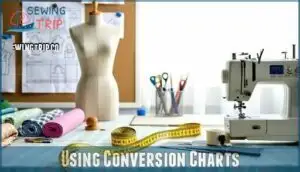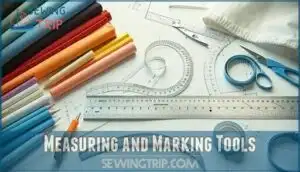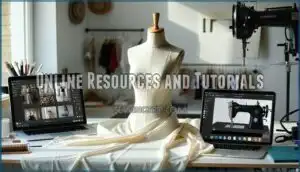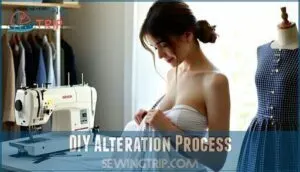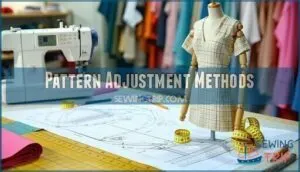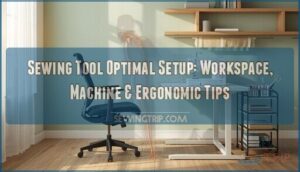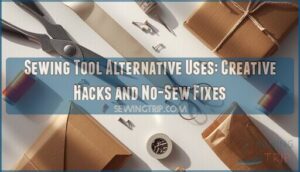This site is supported by our readers. We may earn a commission, at no cost to you, if you purchase through links.

You’ll need to shorten the bodice length, adjust armhole depth, and reduce overall garment proportions—standard patterns assume you’re 5’4" or taller, which leaves petite sewers feeling like they’re wearing their big sister’s hand-me-downs.
Start by measuring your torso from shoulder to waist, then compare it to the pattern’s measurements.
The difference becomes your adjustment amount. Don’t forget sleeve and hem length modifications too.
Master these basics, and you’ll discover some game-changing tricks that transform any pattern.
Table Of Contents
Key Takeaways
- You’ll need to shorten bodice length and adjust armhole depth since standard patterns assume you’re 5’4" or taller, leaving petite sewers with garments that fit like oversized hand-me-downs.
- Calculate your scaling ratio by dividing your height by the pattern’s standard measurement—if you’re 5’0", that’s 60 ÷ 64 = 0.94 or 94%—then apply this percentage to all pattern adjustments for proportional accuracy.
- Blend different pattern sizes together for custom fit by choosing larger sizes for bust measurements and smaller sizes for hips, then smoothly connecting the pattern lines between sizes to eliminate fit issues.
- Focus on raising necklines, narrowing armholes, and adjusting waistline placement since these areas create the most noticeable fit problems on petite frames and dramatically improve your garment’s overall appearance.
Petite Sewing Challenges
You know that sinking feeling when you try on a pattern you’ve spent hours making, only to find the armholes gape like caves and the waistline hits somewhere near your ribs?
When your handmade dress fits like a tent, you know the pattern wasn’t made for your petite frame.
If you’re petite, you’ve probably discovered that standard sewing patterns treat everyone like they’re 5’5", which means your finished garments often look like you borrowed them from your taller sister’s closet.
Importance of Proper Fit
Getting the right fit transforms your entire look, and that’s especially true for petite frames.
When your clothes actually fit your petite body properly, you’ll experience an instant confidence boost while achieving that flattering silhouette you’ve been chasing.
Proper petite alterations guarantee comfort matters as much as style, giving you garment longevity and authentic style expression through personalized petite size tailoring.
Standard Patterns Limitations
Standard patterns create a perfect storm of fit issues for petite frames.
You’re dealing with proportional mismatch that goes beyond simple length adjustments. Here’s what standard patterns get wrong:
- Shoulder width extends too far beyond your natural frame
- Bodice length creates excess fabric around your torso
- Height distribution places seams in awkward positions
- Measurement discrepancies affect overall garment drape
- Armhole placement sits too low for petite proportions
When altering patterns, remember to maintain grainline accuracy for the best results.
Variations in Petite Body Types
Petite doesn’t mean one-size-fits-all in relation to your petite body frame.
You’ll find curvy petite figures need different pattern alteration approaches than slim petite body types.
Your torso length and limb length vary dramatically, even within petite sizing.
Some need bust adjustments while others require hip modifications.
Proportional adjustments for petite sewing must account for these individual differences in petite clothing alterations, considering the unique aspects of each petite body.
Need for Customized Patterns
You deserve clothing that celebrates your unique body instead of fighting against it.
Off-the-rack patterns create proportional challenges that leave you swimming in fabric or constantly adjusting ill-fitting garments.
Customized patterns solve this frustration by addressing your specific needs:
- Flattering fit that enhances your natural silhouette
- Comfort matters – no more tugging or adjusting throughout the day
- Style individuality that reflects your personal taste
- Proper proportions designed for your petite body frame
Alteration Techniques
You’ll need the right tools and techniques to transform those too-big patterns into perfectly fitting garments, and luckily, it’s easier than trying to squeeze into your pre-teen jeans.
Mastering alteration methods using conversion charts, measuring tools, and online guides is key to success.
You’ll turn pattern frustration into sewing success by applying these techniques.
Using Conversion Charts
Anyone can master petite conversion charts with the right approach.
These tools translate standard measurements into petite-friendly dimensions, but chart accuracy varies between brands.
You’ll need measurement consistency to avoid fitting disasters.
| Brand | Height Base | Adjustment Method |
|---|---|---|
| Big 4 | 5’5" | Subtract 3" proportionally |
| Burda | 5’6" | Scale down 93-96% |
| Indie | Varies | Check individual guides |
| Vintage | 5’4" | Add back length first |
Brand variations mean proportional adjustments differ substantially across pattern companies.
Measuring and Marking Tools
Your sewing arsenal needs the right measuring and marking tools for successful pattern alteration on your petite body frame.
Grab rulers and curves for accurate measurements, fabric chalk types that disappear cleanly, seam rippers for mistake fixes, marking pens for precise lines, and a tailors square for perfect angles.
These tools transform pattern modification petite projects from frustrating guesswork into confident sewing pattern alteration success.
You can find specialized sewing gauges for precise measurements.
Online Resources and Tutorials
Digital resources transform pattern alteration for your petite body frame from guesswork into precision.
You’ll find thorough support across multiple platforms, making sewing patterns adjustment accessible and achievable. Many platforms offer pattern alteration courses for continuous learning.
- Video Tutorials on Craftsy and Udemy offer step-by-step petite sewing tutorials with downloadable guides
- Online Communities like Pattern Review provide expert advice and peer support for pattern alteration petite projects
- Digital Pattern Libraries from specialized companies cater specifically to smaller frames
- Sewing Blogs including Learn to Sew and Threads Magazine share free modification techniques
- Virtual Consultations through CreativeLive connect you with fitting experts for personalized guidance
Pattern Drafting Guides
Pattern drafting guides become your best friends when you’re ready to master proportional scaling and customization techniques.
These books teach you advanced draping methods and digital patterning skills that’ll transform how you approach pattern modification petite projects.
You’ll learn the drafting principles behind why certain pattern adjustments work, giving you confidence to tackle any sewing pattern adjustments for your petite body fit needs.
Accurate measurements address petite proportion challenges.
Common Alteration Issues
When you’re altering patterns for your petite frame, you’ll quickly discover that most ready-made patterns come with their own set of frustrating fit problems.
From necklines that plunge too low to armholes that reveal more than you’d like, these common issues can be particularly troublesome.
These issues, which include waistlines that sit awkwardly on your torso and sleeves that seem designed for someone with gorilla-length arms, can make even the simplest sewing project feel like you’re wrestling with fabric that just won’t cooperate.
Neckline and Armhole Adjustments
Your necklines probably gape like a yawning chasm, and those armholes reveal more than you bargained for. Petite frames need specific neckline adjustment and armhole adjustment techniques to prevent undergarment exposure and achieve proper bust fit.
To address these issues, it’s helpful to understand how to make precise neckline alterations. This knowledge will help you tackle the common problems associated with petite clothing.
Here’s how to tackle these petite clothing alterations:
- Raise necklines by trimming excess fabric and reshaping the curve for better petite body fit
- Narrow armholes to eliminate armhole binding while maintaining comfortable shoulder slope movement
- Use pattern modification petite techniques to prevent neckline gaping through strategic dart adjustments, ensuring a proper and comfortable fit.
Waistline and Torso Length Adjustments
When your waistline sits too low on petite dress alterations, it’s like wearing someone else’s belt – everything feels off.
Torso shortening and waistline raising create a comfortable fit that flatters petite proportions through strategic pattern reshaping.
You can find a suitable waistline pattern online for this purpose.
| Issue | Fix | Benefit |
|---|---|---|
| Low waistline | Raise by 1-2 inches | Natural waist placement |
| Long torso | Shorten between bust and waist | Balanced proportions |
| Baggy midsection | Take in side seams | Defined silhouette |
| Poor drape | Adjust dart placement | Smooth fabric flow |
| Uncomfortable fit | Redistribute ease | Better movement |
The key to achieving a flattering fit is making adjustments that address specific issues, such as a low waistline or long torso, to create a balanced silhouette with a smooth fabric flow.
Sleeve and Pant Length Modifications
Getting your sleeve length and pant length just right can make or break your petite look.
You’ll need to reduce sleeves by 1-2 inches through strategic cuts, not simple hemming techniques.
For petite pant alterations, focus on proper inseam measurements and cuff adjustments.
Remember, petite sewing patterns adjustment requires maintaining proportion balance while shortening—your pattern modification petite efforts depend on precision over speed.
Resources are available to help with petite clothing fixes.
Garment Volume Reduction
After adjusting sleeves and pant lengths, you’ll notice your garments still feel baggy and overwhelmed your petite frame.
Volume Distribution becomes your next challenge through strategic Fabric Removal and Silhouette Shaping.
Professional petite clothing alteration services focus on Streamlining Clothes by taking in side seams, reducing shoulder width, and creating better Proportion Adjustment.
These petite clothing modifications transform oversized patterns into flattering fits.
DIY Alteration Process
You’ll transform your too-big garments into perfectly fitted pieces by following three simple steps that don’t require fancy tailoring skills, just like turning your older sibling’s hand-me-downs into clothes that actually look like they were made for you.
Start by washing and drying your garment first, then mark your adjustments while wearing it inside-out, and finish by sewing straight lines that’ll make your clothes hug your petite frame just right.
Pre-alteration Preparation
Before you start snipping and stitching, take time for proper preparation—it’s like laying the foundation for a house.
Begin with fabric pre-treatment by washing and drying your garment to prevent shrinkage surprises later.
Next, conduct thorough garment assessment to identify problem areas. Verify measurement accuracy by double-checking your body dimensions, then organize your workspace setup and confirm tool readiness for smooth petite sewing patterns adjustment.
Mastering thread tension control is also vital for seamless stitches and ensuring a good workspace setup.
Marking and Pinning Techniques
Grab your fabric chalk and mark those adjustment lines like you’re drawing a treasure map.
Pin along your markings with precision, ensuring seam allowance stays consistent throughout your petite sewing patterns adjustment.
These pinning methods and marking accuracy techniques form the backbone of successful sewing pattern fitting techniques, making your petite sewing pattern modification dreams achievable, with precision being key to it all.
Sewing and Trimming Excess Fabric
After pinning along your markings, you’ll sew with a straight stitch, keeping your seam allowance consistent.
Trim excess fabric carefully with sharp cutting tools, leaving about half an inch for safety.
For edge finishing, use a zigzag stitch to prevent fraying, and apply smart trimming techniques to reduce fabric waste, guaranteeing your petite clothing adjustments look professional.
Pattern Adjustment Methods
You’ll master pattern adjustments by calculating a simple scaling ratio that transforms regular patterns into petite-perfect fits, just like shrinking a photocopy to match your actual height.
Once you’ve got your magic number, you can adjust bust, waist, and hip measurements with basic math, then blend different sizes together for a custom fit that actually works.
Calculating Scaling Ratios
Your height ratio becomes the magic number for petite sewing patterns success.
Divide your height by the pattern’s standard 5’4" measurement – if you’re 5’0", that’s 60 ÷ 64 = 0.94 or 94%.
This measurement scaling percentage guides all your pattern resizing decisions, affecting your entire petite body frame, so accurate calculation guarantees custom fitting that actually works.
Adjusting Measurements and Sizes
Once you’ve calculated your scaling ratio, you’ll need to reverse-engineer your body measurements for pattern selection.
Divide your actual bust, waist, and hip measurements by the scaling ratio to find your adjusted sizes. For example, if your bust is 96cm and your scaling ratio is 93%, you’ll need 103.2cm on the pattern’s size chart for proper proportional adjustments.
Using a test muslin helps assess fit before cutting final fabric. This process allows for basic adjustment techniques before committing to your project, enabling you to make proper proportional adjustments and ensuring a good fit.
Blending Sizes for Custom Fit
Now you’re ready to mix and match sizes like a pro chef blending flavors.
Your adjusted measurements rarely match one perfect size, so combining sizes creates your custom fit. Choose XXL for your bust, L for hips, then blend the pattern lines smoothly between sizes.
This sewing pattern blending technique delivers:
- Freedom from ill-fitting clothes that never quite work
- Confidence knowing your garments will actually flatter your frame
- Pride in mastering petite sewing techniques that pros use
- Relief from constant alterations and fitting frustrations
Using Resources for Precise Alterations
Measurement guides and conversion charts become your best friends when tackling petite sewing patterns.
Online communities offer real-world advice from fellow sewers who’ve wrestled with similar fitting challenges.
Pattern drafting resources help you understand the "why" behind alterations, while specialized alteration tools guarantee precise modifications.
These sewing pattern techniques transform frustrating fitting sessions into confident pattern modifications that actually work, making specialized alteration tools essential for precise adjustments.
Frequently Asked Questions (FAQs)
Why is pattern alteration important in sewing?
A stitch in time saves nine when you’re altering patterns.
You’ll achieve perfect fit, eliminate awkward bunching, and create clothes that actually flatter your body instead of drowning you in excess fabric.
What are pattern alteration skills?
Pattern alteration skills let you reshape, resize, and customize sewing patterns to fit your unique body perfectly.
You’ll learn to adjust lengths, widths, curves, and proportions, transforming ill-fitting patterns into garments that flatter your figure beautifully.
How do I know if I need alterations?
You’ll know you need alterations when clothes don’t fit your proportions – necklines gape, sleeves hang past your wrists, waistlines sit too low, or hemlines drag.
Trust your mirror and comfort level.
What should a pattern alterations box hold?
Your sewing toolkit needs measuring essentials: rulers, fabric chalk, sharp scissors, pins, and seam ripper.
You’ll want pattern paper, tracing wheel, and French curve too.
Don’t forget good lighting—it’s your best friend for precise work.
Do I need a toolkit to alter a pattern?
You don’t need fancy equipment to get started.
Basic tools like measuring tape, fabric scissors, pins, and marking chalk will handle most alterations.
Your sewing machine and seam ripper complete the essentials.
Can petite patterns work for tall torsos?
Why fight your proportions when you could work with them?
Petite patterns won’t fit tall torsos well since they’re designed for shorter measurements.
You’ll end up with sleeves, bodice length, and waistlines that don’t match your frame, resulting in a poor fit that can be avoided by choosing patterns that accommodate your proportions.
How do fabric types affect petite alterations?
Different fabrics behave uniquely when you’re making petite alterations.
Stretchy knits forgive minor fit issues, while woven fabrics need precise adjustments.
Heavier materials like denim require stronger seams, and delicate fabrics demand careful handling during alterations.
Whats the difference between petite and junior sizing?
Ever wonder why clothes labeled "petite" and "junior" both seem smaller.
Petite sizing adjusts proportions for shorter frames, while junior sizes target younger body shapes with different bust-to-waist ratios and straighter silhouettes, which includes a distinct approach to petite sizing.
Should shoulder seams be adjusted for petites?
Yes, you’ll often need to adjust shoulder seams for petite frames.
Petite shoulders are typically narrower and positioned closer together than standard patterns assume, so narrowing shoulder width prevents that droopy, oversized look.
Do petite alterations require special sewing machines?
You don’t need special sewing machines for petite alterations.
Your regular home machine works perfectly fine for shortening hems, adjusting waistlines, and taking in seams on basic garments like dresses and pants.
Conclusion
Mastering pattern alteration petite body frame techniques will absolutely revolutionize your sewing game forever.
You’ve got the tools, measurements, and step-by-step process to transform any pattern into your perfect fit.
Remember, it’s all about shortening bodice length, adjusting armholes, and scaling proportions correctly.
Don’t let standard sizing dictate your wardrobe anymore—you’re now equipped to create clothes that fit like they were custom-made.
Your sewing machine’s waiting, so grab those patterns and start altering with confidence.
- https://petitefont.com/standard-petite-sewing-pattern-adjustments-html/
- https://vintageontap.com/petite-pattern-adjustments/
- https://www.sewdirect.com/blog/how-to/petite-pattern-adjustments/
- https://sewing.patternreview.com/SewingDiscussions/topic/88698
- https://textilelearner.net/pattern-alteration-techniques/

